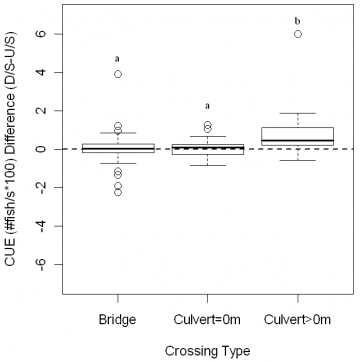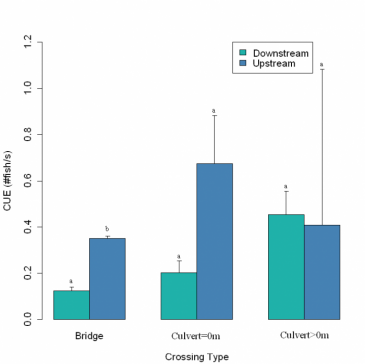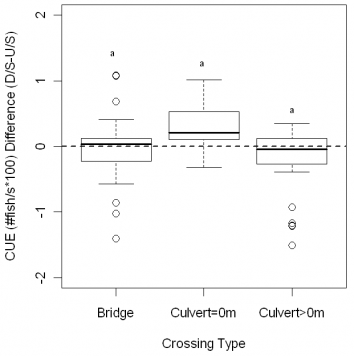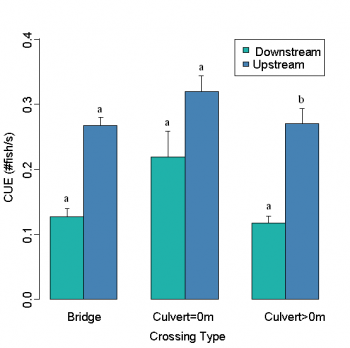2) Do Culvert Structures Impede Fish Passage?
In further analysis, stream
crossing structures were classified into three different crossing
categories; bridges, culverts with no hang height, and culverts with a
hang height. Since our data satisfied the assumptions of normality and
equal variances (Appendix A), for both weak and strong swimming fish
species, a multifactor ANOVA was conducted. This was followed by
pairwise comparisons for each of the crossing categories.
Weak Swimmers
Fig. 5.
Catch per unit effort (#fish/s) difference (downstream-upstream) of
weak swimming fish species belonging to families Gadidae
(burbot), Cyprinidae (northern red belly dace, pearl dace, lake chub,
long nose dace), Gasterosteidae (brook stickleback), Catostomidae
(longnose sucker, white sucker), Cottidae (spoonhead sculpin),
Percopsidiae (trout perch) in three different crossing structure
categories, bridges, culverts with no hang height and culvert with a
hang height. A positive value indicates that at a site more fish
of a particular species were found downstream of a stream crossing,
while a positive value indicates higher presence of a species upstream
of a stream crossing. Different letters indicate a significant (p<0.05) differences between the three crossing types.
Fig.6. Median atch per unit effort (#fish/s) values of weak swimming fish species belonging
to families Gadidae (burbot), Cyprinidae (northern red belly
dace, pearl dace, lake chub, long nose dace), Gasterosteidae (brook
stickleback), Catostomidae (longnose sucker, white sucker), Cottidae
(spoonhead sculpin), Percopsidiae (trout perch) downstream and upstream
in three different crossing structure categories, bridges, culverts
with no hang height and culvert with a hang height.. Different letters indicate a significant (p<0.05) difference between upstream and downstream catch rates.
When comparing catch rates of the
three different crossing categories, there is only a significant
difference between bridges and culverts with a hang height (p=0.02).
There are higher downstream catch rates of weak swimming species at
culverts with a hang height than at bridges. In addition, downstream
and upstream comparisons were made at each of the three crossing
categories. There was no significant difference in weak swimming fish
presence above and below culverts with no hang height (p=0.345) and
culverts with a hang height (p=0.384). There was, however, a difference
at our control bridges (p=0.012). It should be noted, however, that
there were several outlier catch rates that may have skewed this
result. In the multifactor ANOVA analysis there was no significant
interaction effects between the three different crossing categories and
upstream/downstream comparisons.
Strong Swimmers
Fig. 7.
Catch per unit effort (#fish/s) difference (downstream-upstream) of
strong swimming fish species belonging to the family Salmonidae
(rainbow trout, arctic grayling, mountain whitefish) in three different
crossing structure categories, bridges, culverts with no hang height
and culvert with a hang height. A positive value indicates that at
a site more fish of a particular species were found downstream of a
stream crossing, while a positive value indicates higher presence of a
species upstream of a stream crossing. Different letters indicate
a significant (p<0.05) difference.
Fig. 8. Median catch per unit effort (#fish/s) of
strong swimming fish species belonging to the family Salmonidae
(rainbow trout, arctic grayling, mountain whitefish) upstream and
downstream in three different crossing structure categories, bridges,
culverts with no hang height and culvert with a hang height.Different letters indicate a significant (p<0.05) difference.
There was no statistical difference
between the catch rates of strong swimming fish species at the three
different crossing types (p=0.96). However, when comparing downstream
and upstream catch rates at each of the individual crossing types,
there was a significant difference at culverts with a hang height
(p=0.037). Salmonids were more likely to be found upstream of a culvert
with a hang height. There was no significant difference in catch rates
at control bridges (p=0.082) and culverts with no hang height
(p=0.512). In the multifactor ANOVA analysis there was no significant
interaction effects between the three different crossing categories and
upstream/downstream comparisons.





